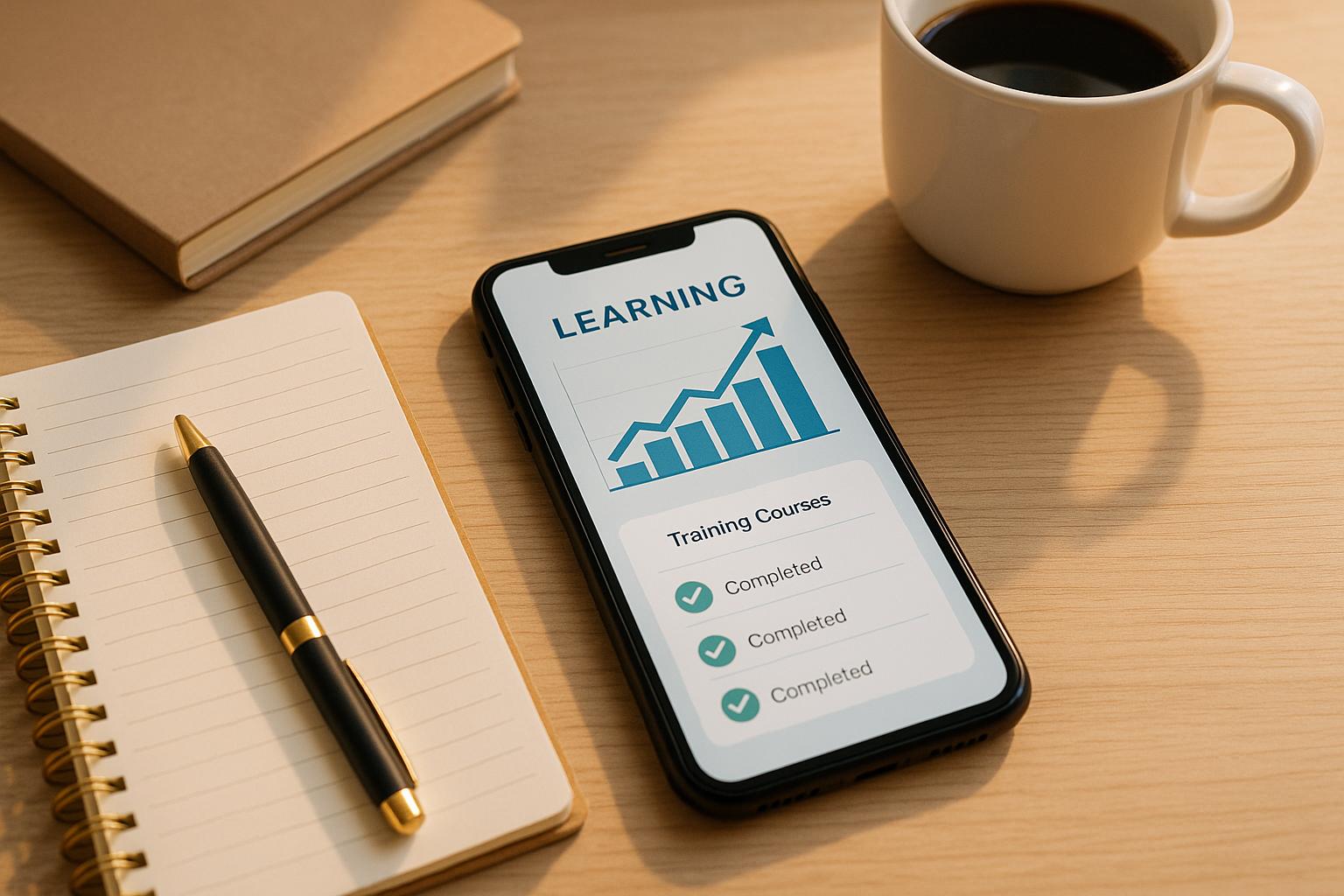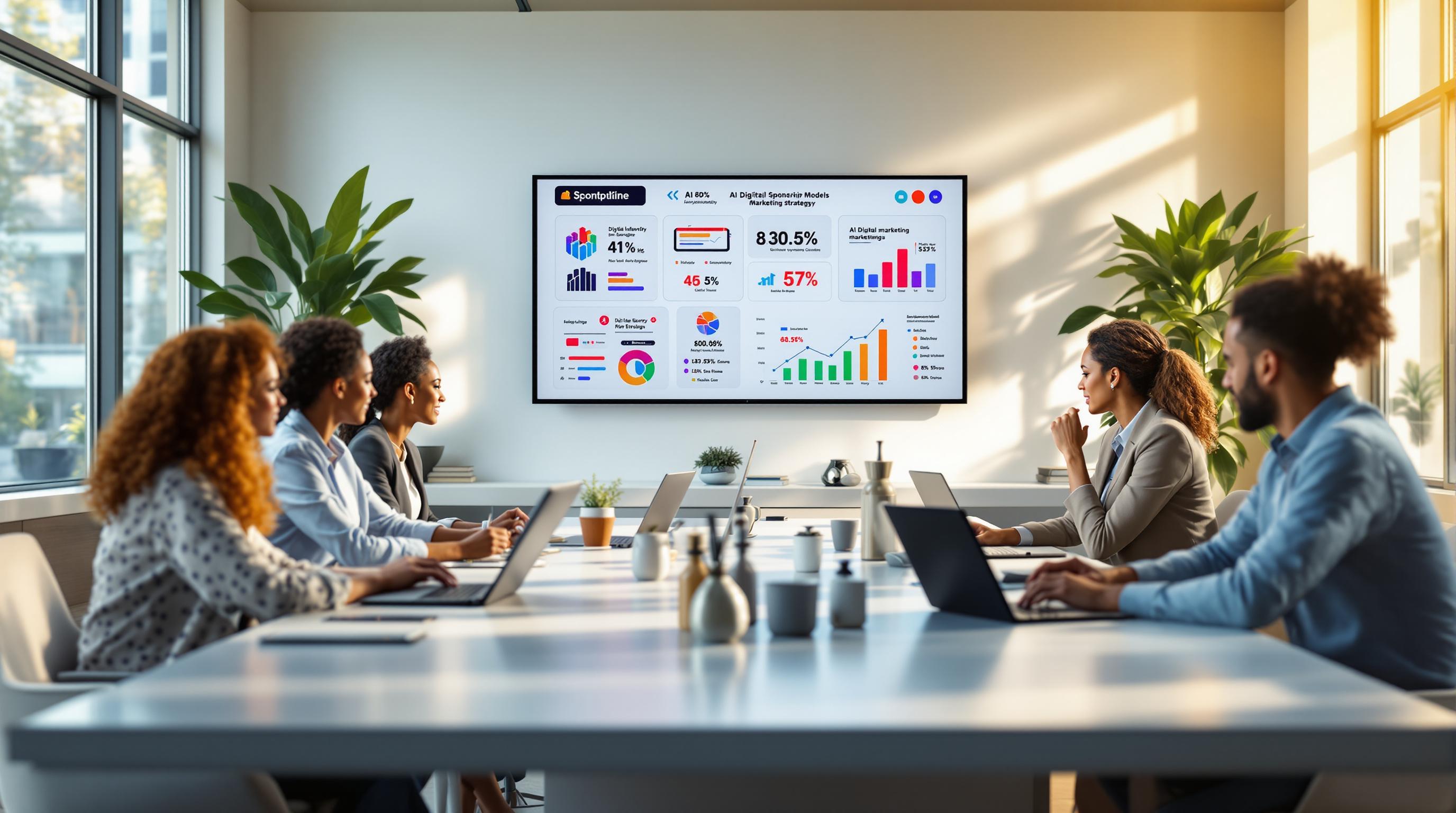When companies acquire digital assets, especially in multi-cloud environments, securing these new additions quickly becomes a challenge. Misconfigurations, outdated security practices, and compliance mismatches can expose the entire organization to risks. This article highlights seven cloud-native security tools that help organizations secure and integrate acquired assets effectively. These tools focus on AI-powered threat detection, multi-cloud support, compliance monitoring, and agentless deployment for seamless integration.
Key Takeaways:
- SentinelOne Singularity: AI-driven, unified visibility across multi-cloud, with hybrid agentless deployment.
- Palo Alto Networks Prisma Cloud: Centralized security for multi-cloud and hybrid setups, with strong compliance tools.
- Wiz: Fully agentless, quick deployment with contextual risk prioritization.
- Aqua Security: Tailored for containers and Kubernetes, with automated remediation.
- Sysdig: Runtime-focused, hybrid deployment with deep Kubernetes insights.
- Check Point CloudGuard: Real-time monitoring and unified policy management.
- Tenable Cloud Security: Strong vulnerability management with AI-based prioritization.
These tools help address common security challenges such as cloud misconfigurations, overly broad permissions, and legacy security debt. Organizations can use these solutions to ensure compliance, protect sensitive data, and maintain operational efficiency during post-acquisition integration.
What is Cloud-Native Application Protection Platforms (CNAPP)?
Security Challenges for Acquired Cloud-Native Assets
Acquiring cloud-native assets brings a unique set of security challenges, especially for companies managing a mix of applications, platforms, and services across multiple cloud environments. These challenges demand careful attention to ensure both security and operational efficiency.
One major hurdle is integrating disparate cloud environments. Acquired companies often rely on different cloud providers like AWS, Microsoft Azure, and Google Cloud Platform, each with its own security models and APIs. This variety can create a fragmented security landscape, especially in hybrid or multi-cloud setups that combine on-premises and cloud infrastructures. Unifying these diverse environments under a cohesive security framework is no small task.
Another critical issue is cloud misconfigurations, which frequently emerge during post-acquisition integration. Problems like publicly exposed storage buckets, overly permissive network security groups, and improperly configured IAM roles are common. These vulnerabilities often go unnoticed until integration begins, leaving gaps that could be exploited if not addressed promptly.
The problem of overly broad permissions is also common in acquired environments. Smaller organizations may rely on broad administrative access for convenience, but when scaled, this approach significantly increases the attack surface. Risks include former employees retaining access to sensitive systems, service accounts with excessive privileges, and temporary access arrangements becoming permanent without oversight.
Compliance alignment adds another layer of complexity. Acquired assets must meet various regulatory requirements, such as GDPR, HIPAA, and SOC 2. Ensuring these assets align with the parent company’s compliance standards requires coordinated audits and the implementation of appropriate security controls.
There’s also the issue of legacy security debt. Some cloud-native applications may have been developed without a strong focus on security, leaving them reliant on outdated encryption protocols, insufficient logging, or poor network segmentation. Addressing these vulnerabilities quickly is essential to protect the broader infrastructure.
Modern tools, such as AI-driven automation, can play a key role in tackling these challenges. These tools can detect anomalies, identify misconfigurations, and recommend fixes in real time, helping to streamline the integration process.
Real-time monitoring and threat detection are equally critical. In dynamic cloud environments - where resources are constantly created, modified, or retired - continuous monitoring provides visibility into configuration changes, access patterns, and potential security incidents as they happen, reducing the risk of undetected threats.
Adding to the complexity are data sovereignty rules, which vary by jurisdiction and dictate where data can be stored and processed. These rules can sometimes conflict with the existing cloud architecture, requiring careful planning or even data migration to ensure compliance without disrupting operations.
For businesses like digital media networks and B2B platforms, these challenges are even more pronounced. High service availability and performance must be maintained during integration, meaning any security fixes need to be carefully coordinated to avoid impacting user experience or business continuity.
Ultimately, addressing these challenges demands specialized tools and strategies tailored to the dynamic nature of cloud-native environments.
1. SentinelOne Singularity Platform
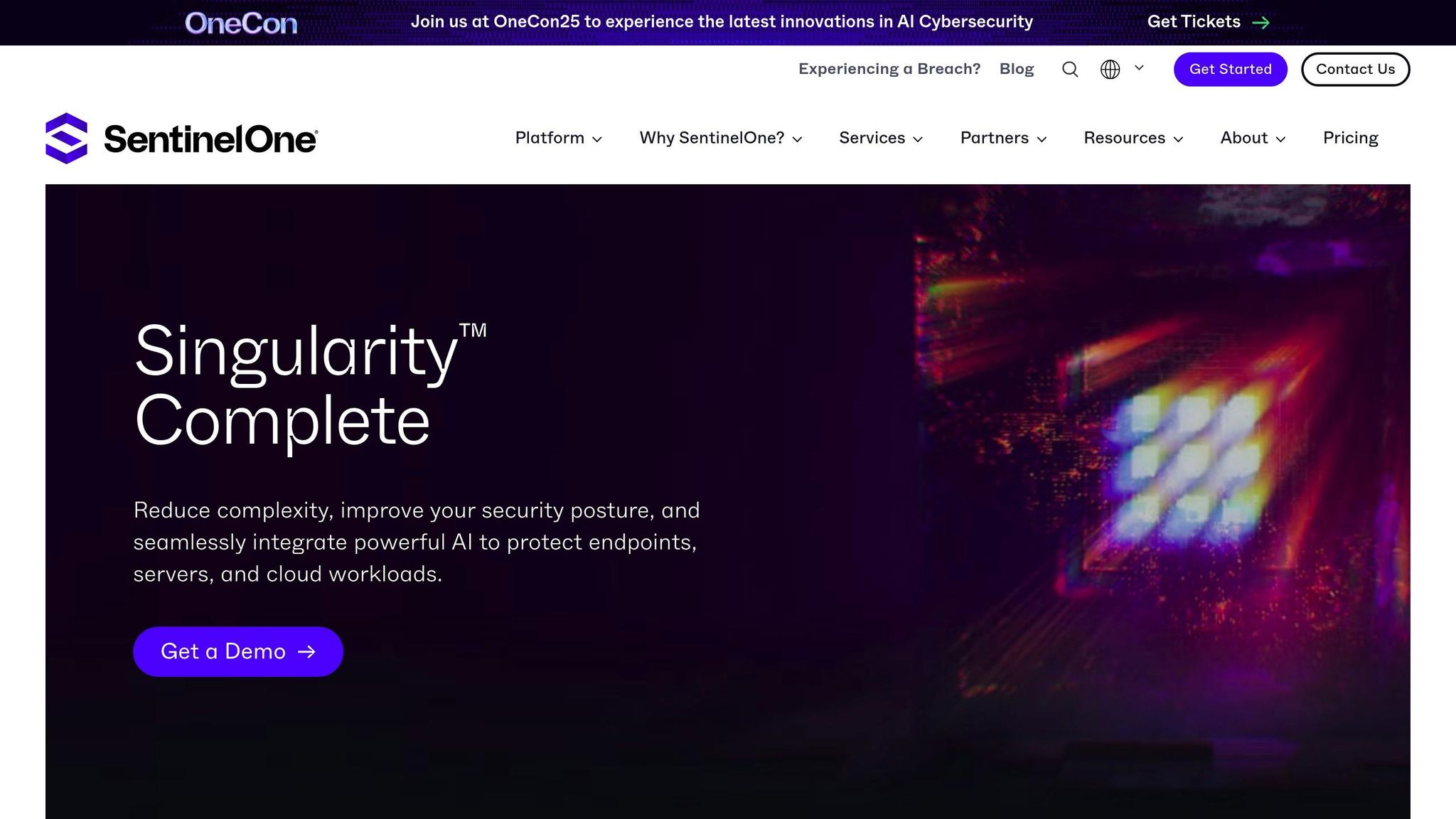
The SentinelOne Singularity Platform is designed to secure cloud-native assets acquired during mergers or expansions. It tackles the common integration hurdles that arise when blending different systems. Let’s dive into how its features address these challenges.
AI-powered threat detection
SentinelOne uses AI to protect newly acquired assets by continuously analyzing workload behavior through its Behavioral AI. This system identifies unusual patterns that could signal security threats or inherited misconfigurations from the acquired systems.
By establishing baselines for normal activity, the platform can quickly spot and flag anything out of the ordinary. This is especially useful when integrating assets from companies with varying security standards or practices.
Multi-cloud and hybrid environment support
Managing multiple cloud platforms can be overwhelming, but SentinelOne simplifies this with unified visibility across AWS, Microsoft Azure, Google Cloud Platform, and even on-premises environments - all through one management console.
This consolidated approach eliminates the need to juggle separate security tools for each provider, reducing complexity and minimizing the risk of security gaps. The platform also automatically catalogs cloud resources, providing clarity on each asset’s security status.
Agentless deployment
One standout feature is the platform’s agentless deployment, which allows organizations to immediately monitor and secure acquired cloud-native assets without needing to install agents on every system. This avoids disruptions to ongoing operations and minimizes the need for extensive coordination with the acquired company’s IT team.
As the integration process evolves, organizations can transition to deeper, agent-based security measures for enhanced protection.
Compliance monitoring and remediation
Once integration and detection issues are addressed, compliance becomes a top priority. SentinelOne simplifies this with built-in compliance monitoring tools that align assets with regulatory standards such as SOC 2, PCI DSS, and GDPR. The platform automatically scans cloud configurations to identify any compliance gaps.
When gaps are found, it offers detailed remediation guidance, outlining the exact steps needed to align with regulations. This automated process saves time and effort, ensuring that newly integrated environments meet compliance requirements efficiently.
Additionally, the platform maintains thorough audit trails of security events and remediation actions. These records are invaluable for compliance audits and demonstrate a strong commitment to securing acquired assets.
2. Palo Alto Networks Prisma Cloud
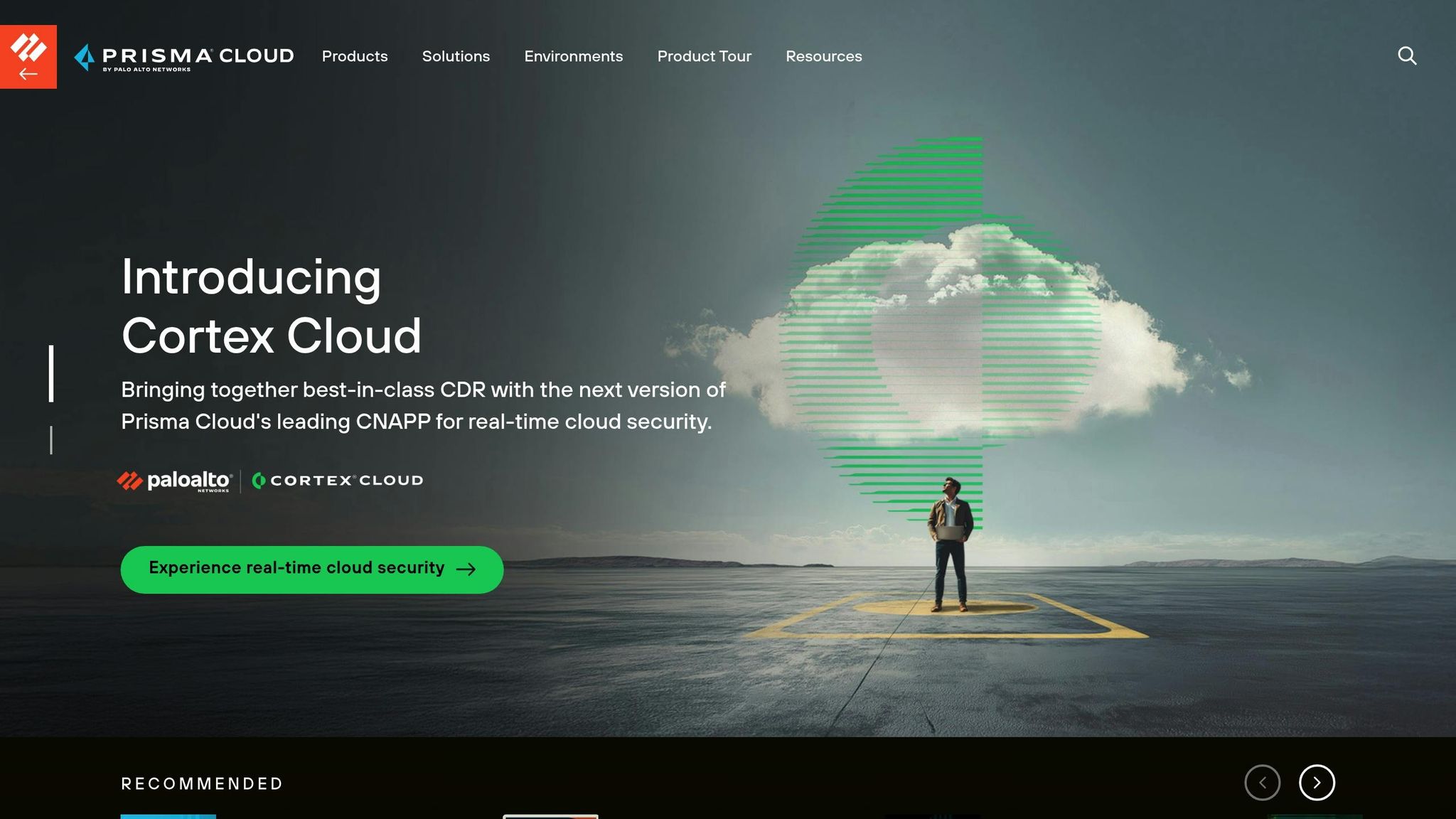
Palo Alto Networks Prisma Cloud offers robust security for digital assets across multi-cloud environments, making it a powerful tool for managing acquisitions. It provides instant visibility and control over newly integrated cloud infrastructures, all while ensuring that existing operations remain unaffected. Let’s dive into how Prisma Cloud tackles the challenges of integrating acquired environments.
Multi-cloud and Hybrid Environment Support
Prisma Cloud is designed to handle the complexities of acquisitions involving multiple cloud providers. With centralized security management, it consolidates oversight across AWS, Microsoft Azure, Google Cloud Platform, Oracle Cloud Infrastructure, and Alibaba Cloud - all accessible through a single dashboard.
What sets it apart is the ability to inventory resources across a broader range of providers, including Oracle Cloud Infrastructure and Alibaba Cloud. This feature helps security teams quickly identify inherited assets, including undocumented shadow IT resources that may have been overlooked during due diligence.
The platform also supports hybrid cloud setups, which is critical when acquired companies operate both cloud-based and on-premises systems. This flexibility allows organizations to maintain their hybrid configurations while transitioning to their preferred cloud strategy at their own pace.
Agentless Deployment
Prisma Cloud’s agentless deployment simplifies and speeds up security integration. It enables immediate monitoring of cloud workloads, containers, and serverless functions without requiring agents, though deeper agent-based protection is available if needed.
This approach minimizes disruptions during the integration process. The agentless scanning feature covers vulnerability assessments, compliance checks, and configuration analysis across compute instances, storage, and network setups. This ensures that security measures are in place from the start, even in environments where production changes need to be kept to a minimum.
AI-Powered Threat Detection
Prisma Cloud uses AI-driven threat detection to uncover misconfigurations and vulnerabilities that may have been inherited during the acquisition. Its machine learning algorithms establish behavioral baselines for the newly integrated cloud environments. The Anomaly Detection engine monitors resource usage, network traffic, and user behavior, identifying unusual activities that could signal compromised credentials, insider threats, or overlooked misconfigurations.
This feature is particularly useful when integrating companies with differing security practices. Additionally, Prisma Cloud’s threat intelligence is continuously updated, ensuring that the latest detection rules are applied automatically. This means acquired assets are always protected against emerging threats without the need for manual updates.
Compliance Monitoring and Remediation
Acquisitions often bring regulatory challenges, but Prisma Cloud simplifies compliance management with automated monitoring. It includes pre-built frameworks for key standards like SOC 2, ISO 27001, NIST, HIPAA, and PCI DSS, making it easier to align newly acquired assets with required regulations.
When scanning new environments, Prisma Cloud identifies compliance gaps and provides prioritized remediation steps. Its Policy-as-Code approach ensures consistent enforcement of compliance standards across all assets, regardless of their original configuration or cloud provider.
For organizations in heavily regulated industries, the platform offers detailed audit trails and generates compliance reports. These reports not only demonstrate due diligence but also prove invaluable during regulatory reviews or customer security audits.
3. Wiz
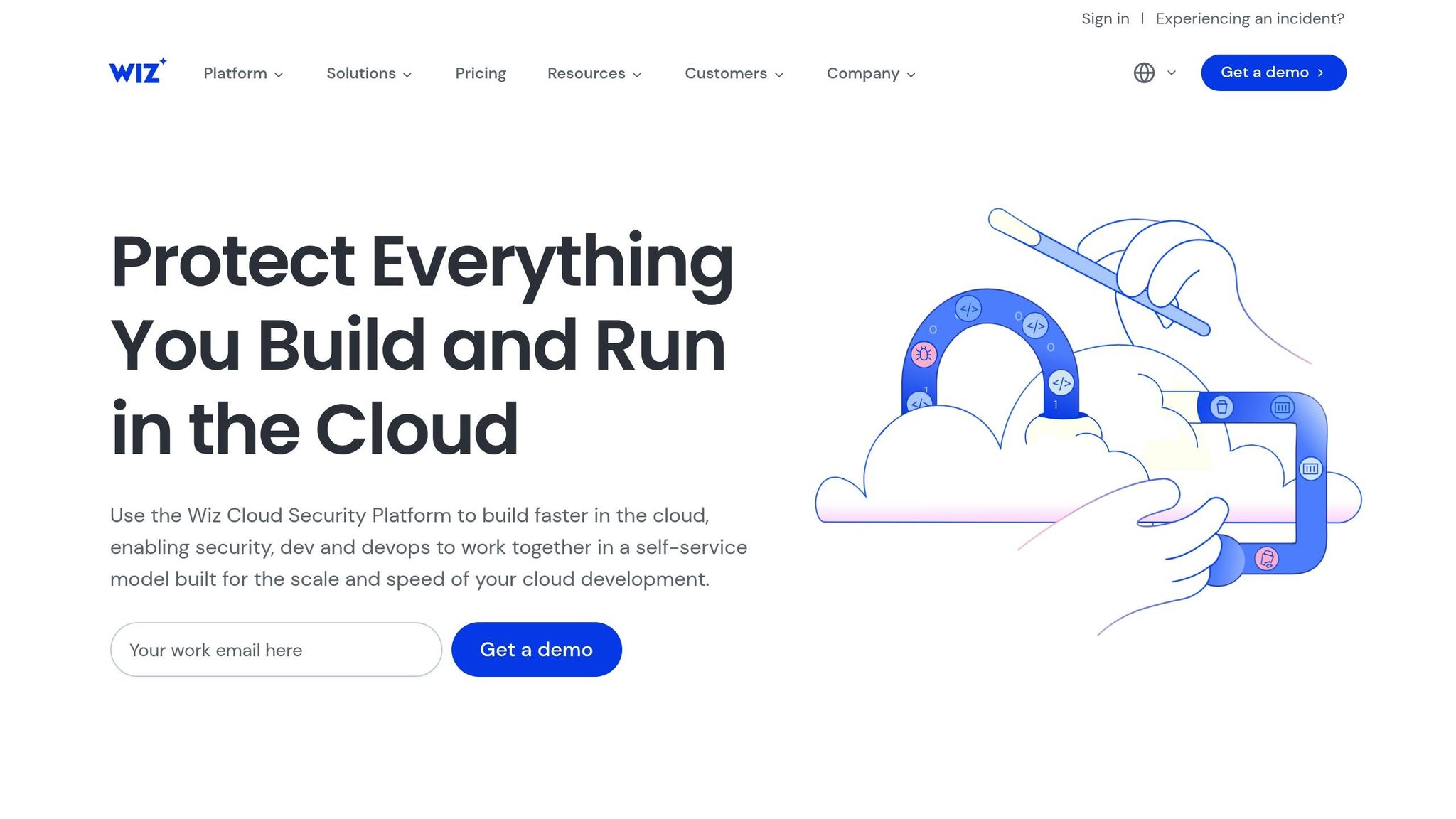
Wiz is a cloud security platform tailored for seamless integration of acquired assets, using an agentless design that simplifies the process. Trusted by over 50% of Fortune 100 companies and recognized as a Leader in the 2025 IDC MarketScape for CNAPP, Wiz has established itself as a reliable solution for enterprise acquisitions.
The platform addresses the security challenges that come with integrating newly acquired assets. Its agentless design ensures quick deployment and compliance without the complexities of traditional agent-based systems. This capability is especially useful when onboarding organizations with varied cloud setups or limited resources for security implementation.
Agentless Deployment
Wiz's agentless architecture removes the usual hurdles of securing cloud assets during acquisitions. By relying on cloud provider APIs and metadata, it offers complete visibility from day one.
This approach has clear advantages. Wiz automatically identifies new resources as they are created through cloud APIs, ensuring 100% coverage at scale with minimal administrative effort. Importantly, it achieves this without affecting production performance. Unlike agent-based solutions, which often require time-consuming manual installations, Wiz delivers immediate security coverage.
Multi-cloud and Hybrid Environment Support
Wiz's Cloud Security Posture Management (CSPM) platform provides automatic and seamless security coverage across multiple cloud providers. It monitors a variety of assets, including servers, virtual machines, and applications, regardless of their original cloud configurations.
The platform is designed to scale effortlessly. New resources are automatically detected and monitored without manual setup, allowing security coverage to grow alongside the organization. This adaptability ensures that as the integrated environment expands, security remains consistent and comprehensive.
AI-powered Threat Detection
Wiz incorporates advanced threat detection capabilities, supporting 120,000+ vulnerabilities across 40+ operating systems. Its extensive vulnerability catalog is particularly valuable during acquisitions, where diverse systems often need to be secured.
The platform also provides custom rules to identify misconfigurations and vulnerabilities at both the cloud and host levels, all without requiring agents. This customization allows teams to address the unique risks and setups inherited from acquired companies.
Wiz enhances threat management with a contextual risk view, helping security teams prioritize vulnerabilities effectively. By focusing on the most critical threats, teams can avoid being overwhelmed by generic alerts and take action where it matters most.
Compliance Monitoring and Remediation
In addition to its detection features, Wiz simplifies compliance monitoring by offering a centralized dashboard. This unified view allows security teams to manage and respond to issues directly within the Wiz platform, streamlining the process of meeting regulatory and corporate security standards.
The agentless design also makes it easier to adapt to new compliance requirements, avoiding the constraints of agent-based solutions. This is particularly helpful when aligning acquired companies with new security policies or regulations.
Operationally, Wiz reduces maintenance burdens. Unlike agent-based systems that require frequent updates and management, Wiz handles this through its service provider. This frees up internal teams to focus on strategic tasks, such as ensuring smooth integration and addressing broader security goals.
4. Aqua Security
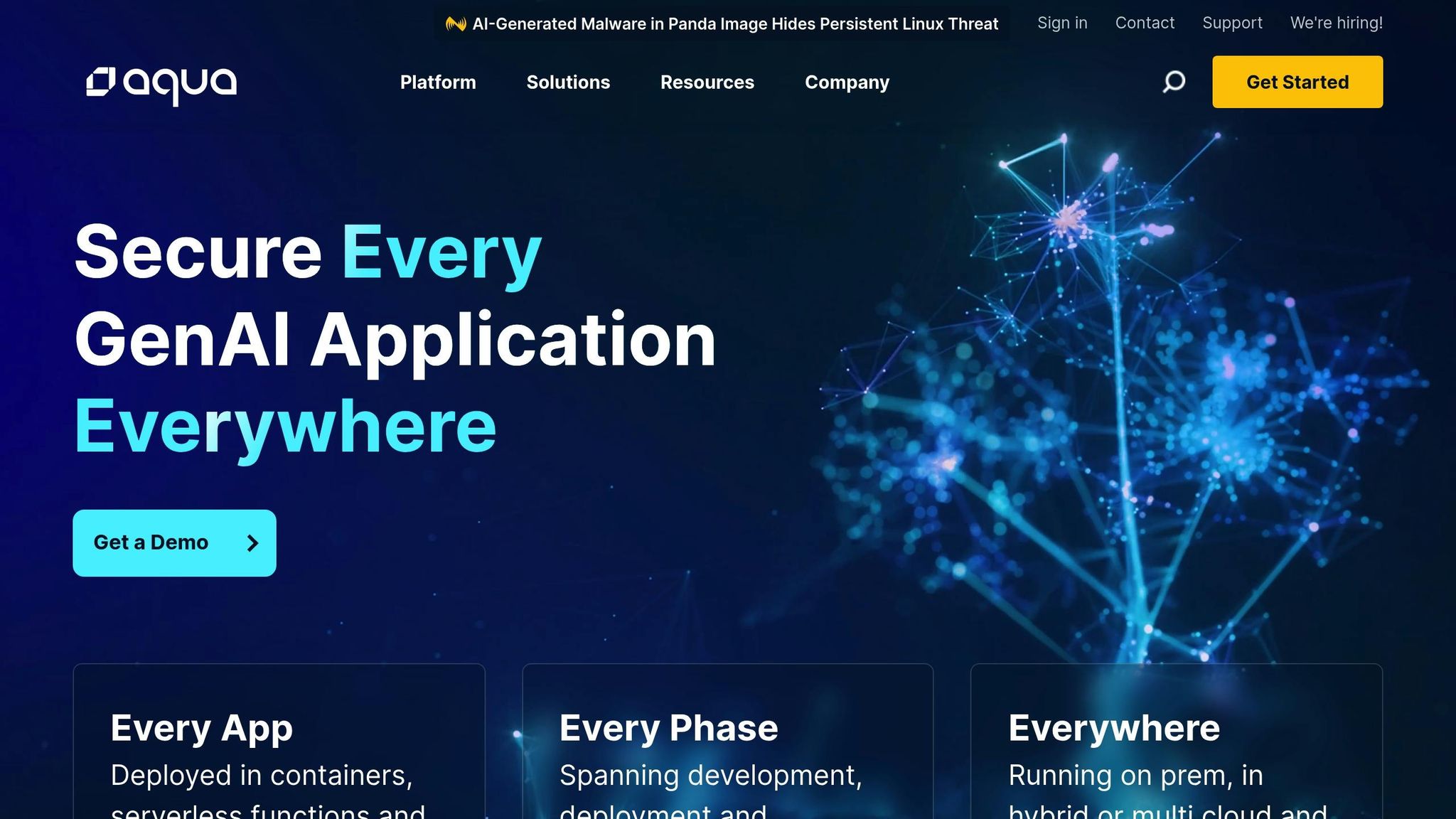
Aqua Security focuses on safeguarding cloud-native applications, making it a strong choice for companies integrating containerized and Kubernetes-based environments after acquisitions. The platform secures every stage of the application lifecycle - from development to runtime - while addressing inherited security vulnerabilities. It ensures smooth operations, even when merging companies built on modern cloud-native architectures.
Aqua Security excels at tackling the unique security challenges of containers and Kubernetes. For organizations acquiring businesses that rely on microservices and containerized setups, Aqua Security delivers the specialized tools required to maintain high security standards.
Multi-cloud and Hybrid Environment Support
Aqua Security's flexibility across cloud platforms makes it an effective solution for acquisitions involving diverse environments. It supports AWS, Azure, Google Cloud, and on-premises infrastructures, ensuring seamless integration.
The platform's Cloud Security Posture Management (CSPM) feature automatically identifies and evaluates cloud resources across various environments. This provides instant visibility into newly acquired assets, offering a clear picture of their security status.
Additionally, Aqua Security handles multi-cluster Kubernetes deployments, allowing centralized management of security policies across different Kubernetes distributions and versions. This ensures consistent protection, even in complex, multi-cloud setups.
AI-powered Threat Detection
Aqua Security uses machine learning through its Dynamic Threat Analysis (DTA) to monitor containerized applications in real time. It detects unusual behaviors, scans for vulnerabilities, and identifies malicious components within container images.
This AI-driven system quickly establishes normal behavior patterns for new applications and infrastructure. It flags deviations that may signal security issues, malware, or unauthorized access attempts. The platform also strengthens security by scanning third-party components and base images for risks within the supply chain of acquired applications.
Compliance Monitoring and Remediation
In addition to threat detection, Aqua Security simplifies regulatory compliance for cloud-native environments. It supports frameworks like PCI DSS, HIPAA, and SOC 2, ensuring that newly acquired assets meet necessary standards from the start.
The platform employs a policy-as-code approach, enabling consistent enforcement of compliance rules across all environments. This simplifies the process of aligning acquired companies with corporate security policies.
Aqua Security also provides automated remediation, fixing common misconfigurations and security issues without requiring manual effort. Automated compliance reports and audit trails offer clear insights into the security posture of acquired entities. These reports can be customized for different business units, making the integration process transparent and efficient.
sbb-itb-01010c0
5. Sysdig
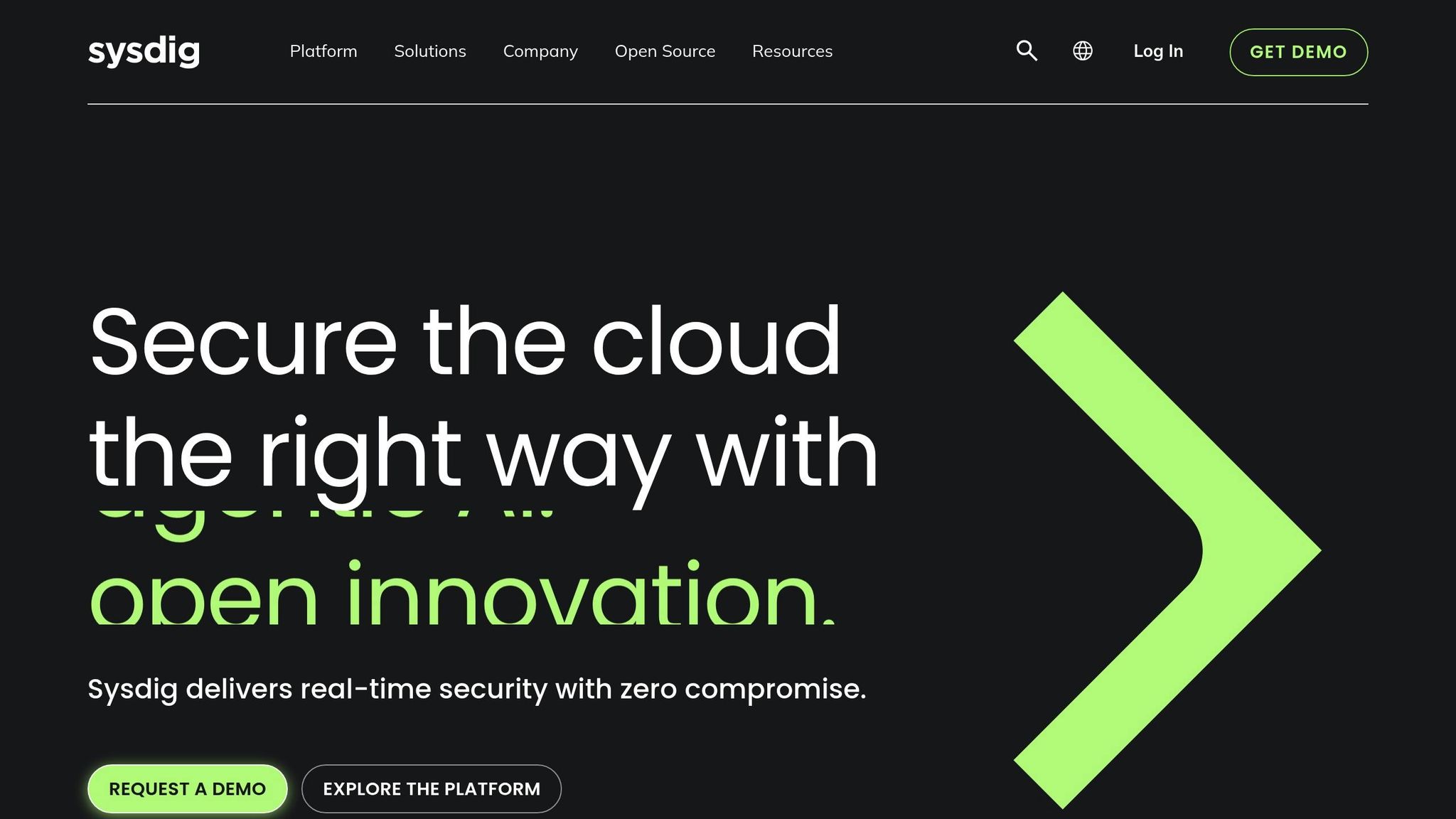
When it comes to managing the challenges of integrating diverse cloud environments, Sysdig steps up as a go-to solution for securing complex, containerized deployments. It provides a unified approach to cloud-native security, offering runtime protection and deep visibility into containerized systems. This makes it particularly helpful for companies dealing with the integration of newly acquired assets, especially those involving intricate Kubernetes setups. With real-time monitoring and threat detection, Sysdig ensures security across the entire cloud-native stack, delivering the immediate visibility and protection needed during post-acquisition transitions.
Sysdig stands out by offering detailed insights into application behavior and infrastructure performance. For businesses navigating the tricky waters of post-acquisition integration, its ability to quickly establish a baseline security posture and spot anomalies is crucial for keeping operations running smoothly.
Agentless Deployment
Sysdig simplifies deployment with its agentless Cloud Security Posture Management (CSPM). By connecting directly to cloud APIs, it removes the need for installing software across various environments - an invaluable feature during acquisition integrations.
The platform provides instant insights into resources on AWS, Azure, and Google Cloud, allowing security teams to evaluate newly acquired assets within hours. This enables quick identification of misconfigurations or compliance issues without interrupting ongoing operations.
For containerized environments, Sysdig leverages the Falco runtime security engine. This lightweight tool monitors system calls and Kubernetes audit logs, delivering extensive threat detection without dragging down performance.
AI-Powered Threat Detection
Sysdig uses machine learning to power its Secure DevOps Platform, analyzing runtime behavior to establish baselines for applications and infrastructure. Its Runtime Insights feature links security events across network traffic, system calls, and application logs, helping teams differentiate between regular operational changes and actual security threats - a key capability during post-acquisition periods.
The platform also addresses supply chain security by scanning container images for vulnerabilities in acquired applications. Its AI-driven analysis prioritizes vulnerabilities based on runtime exposure, enabling teams to focus their efforts on the most pressing security gaps inherited during acquisitions.
Multi-Cloud and Hybrid Environment Support
Sysdig excels in managing security across multiple cloud environments, a common challenge during acquisitions involving companies with varied cloud strategies. It integrates seamlessly with AWS, Microsoft Azure, Google Cloud, and on-premises Kubernetes distributions, providing a unified security solution.
The Sysdig Secure console offers a centralized view for managing security policies across multiple cloud accounts and regions. This simplifies the process of applying corporate security standards to newly acquired infrastructure, regardless of the cloud provider.
For hybrid setups, Sysdig ensures consistent security monitoring and policy enforcement across public clouds, private data centers, and edge locations. This flexibility is critical for acquisitions involving companies operating in diverse deployment models or undergoing cloud migrations.
Compliance Monitoring and Remediation
Sysdig automates compliance checks for key regulatory frameworks like SOC 2, PCI DSS, NIST, and CIS benchmarks, addressing the alignment challenges that often arise during acquisitions. It continuously evaluates cloud resources against these standards, providing real-time compliance scores and actionable remediation steps.
The Compliance Dashboard offers executives a clear view of the security posture of acquired assets. It highlights compliance gaps and tracks remediation progress, helping organizations quickly align new acquisitions with corporate governance standards.
Sysdig also integrates Infrastructure as Code (IaC) scanning to catch compliance issues before they hit production. By working with tools like Terraform, CloudFormation, and Kubernetes YAML, it ensures security policies are enforced throughout the development lifecycle. This proactive approach strengthens security for both existing and newly acquired applications, making Sysdig a solid choice for securing assets across diverse environments.
6. Check Point CloudGuard
Check Point CloudGuard offers a cloud-native security solution designed to protect digital assets during post-acquisition integration. It uses real-time monitoring and automated compliance checks to identify misconfigurations and safeguard assets without interfering with daily operations. The platform simplifies security by unifying policy management across cloud environments, making it easier to integrate new assets into existing security systems seamlessly.
7. Tenable Cloud Security
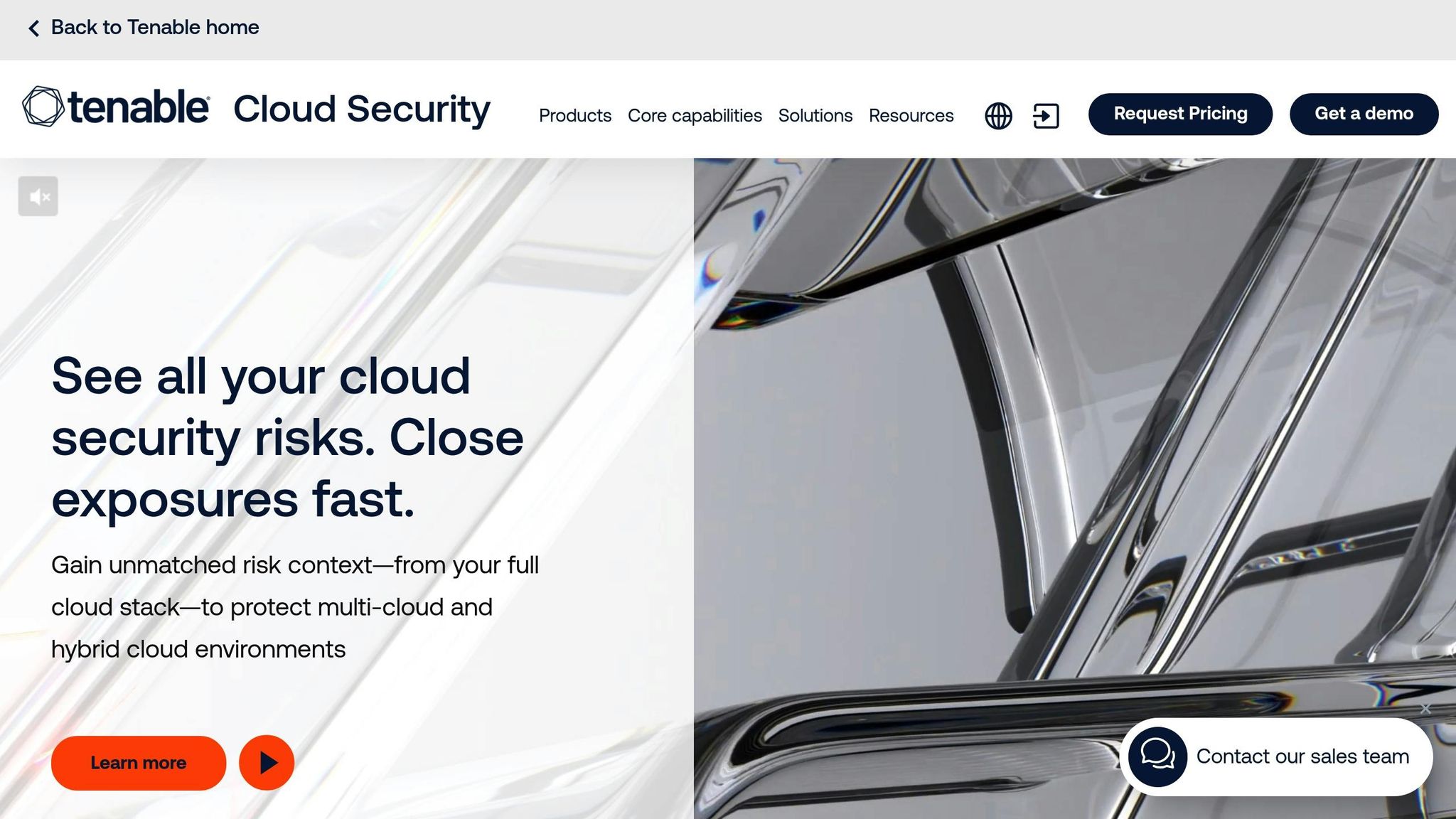
Tenable Cloud Security offers a solution for managing vulnerabilities in newly acquired assets. Its focus lies in identifying security weaknesses across acquired infrastructures while ensuring operations remain uninterrupted during complex merger and acquisition processes. Among tools designed to secure acquired assets, Tenable distinguishes itself by emphasizing quick detection and resolution of vulnerabilities.
The platform leverages integrated security frameworks to address gaps inherited during acquisitions, ensuring a seamless transition without compromising security.
Agentless Deployment
Tenable’s agentless design eliminates the need for software installation, enabling rapid scanning and monitoring - often within hours. This setup allows security teams to assess acquired cloud infrastructure without disrupting ongoing operations. By connecting directly to cloud APIs, the platform provides instant visibility into workloads, configurations, and vulnerabilities, ensuring daily activities remain unaffected.
For legacy systems, this agentless approach is especially beneficial, avoiding the performance issues that traditional methods might cause. Security teams can efficiently map the attack surface of acquired assets and address critical vulnerabilities before the full integration process begins.
AI-Powered Threat Detection
Tenable uses AI to prioritize vulnerabilities based on their exploitability and the criticality of affected assets, rather than relying solely on severity scores. The AI engine evaluates threat intelligence, exploit availability, and the importance of assets to help teams focus on the most pressing risks first. This feature is particularly valuable when dealing with the increased attack surface that comes with acquisitions.
With machine learning continuously adapting to new threats, the platform ensures emerging risks in acquired environments are promptly addressed. This AI-driven approach sharpens the focus on vulnerabilities that pose the greatest threat to business operations.
Multi-Cloud and Hybrid Environment Support
Tenable enforces consistent security policies across platforms like AWS, Microsoft Azure, and Google Cloud, a necessity for acquisitions involving diverse infrastructures. The platform simplifies integration by maintaining uniform security policies and monitoring across different cloud environments.
For hybrid setups, it extends protection to on-premises systems often included in cloud-based acquisitions. This unified interface allows security teams to manage both cloud-native and traditional environments, providing comprehensive visibility without the need to juggle multiple tools.
Compliance Monitoring and Remediation
The platform comes equipped with compliance frameworks for standards like SOC 2, PCI DSS, and HIPAA, which are critical when acquiring companies in regulated industries. Maintaining compliance helps avoid penalties and ensures smooth operations after acquisition. Tenable maps security findings to corresponding compliance controls, giving organizations a clear view of their compliance status.
Additionally, the platform offers automated remediation guidance with step-by-step instructions to close compliance gaps in acquired assets. It also generates detailed reports for auditors and regulators, which can be especially helpful when acquired entities operate under different compliance requirements than the parent organization.
Feature Comparison Table
When selecting a cloud-native security tool for acquired assets, it's essential to evaluate each platform's ability to address post-acquisition security needs. Below is a detailed comparison of key features to help identify the most suitable option. This table breaks down critical capabilities and highlights what sets each tool apart.
| Tool | Agentless Deployment | AI/ML Capabilities | Compliance Monitoring | DevOps Integration | Key Strengths | Primary Considerations |
|---|---|---|---|---|---|---|
| SentinelOne Singularity | Hybrid (mix of agent-based and agentless) | Uses AI for detecting threats | Covers major compliance frameworks | Works with CI/CD pipelines | Offers quick threat response and automated remediation | Higher costs may apply for full features |
| Palo Alto Networks Prisma Cloud | Primarily agentless scanning | Uses machine learning for anomaly detection | Supports industry-wide compliance standards | Seamlessly integrates with CI/CD tools | Provides broad cloud security coverage | Can be complex to configure |
| Wiz | Fully agentless design | Uses ML to prioritize risks | Supports major compliance frameworks | Natively integrates with code repositories | Allows fast deployment and unified security | Limited functionality for on-premises systems |
| Aqua Security | Agentless scanning for cloud; agents for runtime monitoring | Employs AI for assessing vulnerabilities | Includes compliance templates | Tailored for containerized and serverless setups | Strong focus on container and serverless security | May require extra training for non-containerized setups |
| Sysdig | Hybrid (agentless discovery with optional agents) | Uses ML for detecting anomalies | Covers essential compliance frameworks | Integrates with Kubernetes and infrastructure-as-code tools | Excels in runtime security and forensic analysis | High resource demands for large-scale deployments |
| Check Point CloudGuard | Fully agentless | AI powered by threat intelligence | Meets regional and global compliance standards | Supports API integration with CI/CD tools | Ensures consistent multi-cloud security | Limited automation options for DevOps workflows |
| Tenable Cloud Security | Agentless scanning | Uses AI for prioritizing vulnerabilities | Supports key compliance standards | REST API available for DevOps integration | Excels in asset discovery and vulnerability management | Primarily centers on vulnerability assessments |
Factors like deployment speed, cost, and integration options can vary significantly. Matching the right tool to your acquisition strategy is key to achieving optimal security outcomes.
How The B2B Ecosystem Supports Security Optimization
Choosing the right cloud-native security tools for acquired assets involves more than just picking software - it requires thorough evaluation, seamless implementation, and ongoing refinement. The B2B Ecosystem steps in to simplify this process, offering businesses a structured, multi-layered approach to strengthen their security investments.
The platform's curated directories make selecting pre-vetted security tools straightforward. Security teams can browse cloud-native solutions organized by specific categories, eliminating the need for time-consuming vendor research. These directories cover essential areas like AI/ML security, governance risk and compliance automation, and third-party risk management - critical considerations when integrating newly acquired digital assets. This curated selection builds on earlier technical measures, ensuring a smooth extension of security efforts.
To further streamline the process, The B2B Ecosystem leverages AI-powered tools that enhance decision-making. For example, the Risk Analyzer evaluates potential security gaps by analyzing financial and market data, delivering clear, objective risk scores. This eliminates guesswork, helping organizations focus on the most pressing threats. Meanwhile, the AI Process Optimizer identifies outdated security practices that could lead to vulnerabilities during asset integration, ensuring resources are used effectively.
Consulting services provide hands-on support for implementing security strategies. The platform's advisory team works with organizations to create governance frameworks tailored to acquired assets. These frameworks address specific challenges, such as maintaining compliance across diverse cloud environments or managing security policies for assets at different maturity levels. Advisors also conduct detailed risk assessments, considering both technical flaws and operational weaknesses, to accelerate the optimization process.
Educational resources play a key role in keeping security teams ahead of the curve. The platform offers digital publications with expert insights on cloud-native security trends and case studies that showcase real-world success stories. Community forums provide a space for professionals to exchange ideas, share experiences, and discuss effective solutions for common challenges.
Beyond tools and education, post-acquisition security requires strong partnerships. The platform’s marketplace connects organizations with vendors specializing in areas like container security and compliance automation. This targeted matchmaking ensures businesses collaborate with experts who have deep knowledge in cloud-native security, rather than relying on generalist providers.
| Category | Solutions Available in B2B Ecosystem Directories |
|---|---|
| AI/ML Security | AI Governance, LLM Security |
| Application Security | - |
| Data Security | - |
| Governance, Risk, and Compliance | Compliance Automation, Third-Party Risk Management |
| Identity Security | - |
| Infrastructure Security | - |
This comprehensive approach highlights that effective security isn’t just about picking the right tools - it’s about refining processes, leveraging expert advice, and adapting to evolving needs. The B2B Ecosystem ensures organizations are equipped not only to secure their current assets but to scale their security strategies as their portfolios expand.
Conclusion
Bringing newly acquired digital assets into your ecosystem isn’t just about merging systems - it’s about tackling the unique challenges of cloud integration head-on. Picking the right cloud-native security tools plays a critical role in shaping your organization’s overall security strategy. The ever-evolving nature of cloud environments, combined with the risks of incorporating unvetted assets, demands smart, adaptable solutions.
The seven tools discussed - from SentinelOne to Wiz - are designed to address key vulnerabilities, provide extensive coverage for acquired assets, and deliver much-needed visibility in complex cloud setups. Ignoring factors like misconfigurations, unpatched vulnerabilities, or blind spots in newly acquired environments can leave organizations exposed to threats that jeopardize the success of an acquisition.
AI-powered automation steps in as a game-changer, enabling quick threat detection and response without requiring constant manual intervention. At the same time, automated compliance monitoring ensures that newly integrated assets meet critical standards like GDPR, HIPAA, or PCI-DSS. Falling short on compliance can lead to costly data breaches and operational setbacks - risks no organization can afford.
A thoughtful combination of advanced security tools and strategic best practices is the key to successful and secure integrations. By investing in robust cloud-native security solutions and continuously refining your approach, your organization can reduce risks and confidently pursue growth in a highly dynamic digital landscape.
FAQs
How do cloud-native security tools help secure acquired assets in multi-cloud environments?
Cloud-native security tools make it easier to protect assets in multi-cloud environments by offering consistent security policies and automated threat detection. These tools provide real-time visibility across different platforms, allowing organizations to quickly spot and fix vulnerabilities.
They also help reduce risks by addressing misconfigurations, ensuring regulatory compliance, and simplifying security operations. With features like AI-powered monitoring and micro-segmentation, these tools enable smooth integration of new assets while minimizing potential security gaps in complex multi-cloud setups.
What are the advantages of using agentless deployment to secure newly acquired digital assets?
Agentless deployment offers a streamlined way to secure newly acquired digital assets. By skipping the need to install software agents on individual devices, it cuts down on resource demands and sidesteps potential compatibility issues. This means security measures can be implemented more quickly and efficiently.
Another standout benefit is scalability. Agentless deployment works well in dynamic or large-scale environments, providing swift coverage across distributed systems. For businesses managing multiple acquisitions or fast-changing cloud setups, this approach ensures their digital infrastructure is secured without unnecessary delays or interruptions.
How does AI-powered threat detection improve the security of cloud-native assets during post-acquisition integration?
AI-driven threat detection enhances the security of cloud-native assets during post-acquisition integration by spotting advanced threats, unusual behavior, and misconfigurations as they happen. Using automation, these tools can quickly analyze risks and respond, minimizing potential harm and helping the integration process run smoothly.
By keeping a constant watch on data flows, user activities, and workload patterns, AI tools can identify unauthorized access or policy violations early, stopping issues before they grow. This forward-looking approach helps protect your newly acquired assets and keeps them in line with compliance requirements during this crucial phase.
